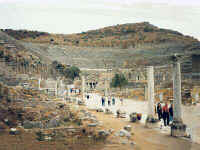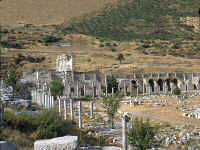|
Page 1 2 3 4 5 6 7 8 9 10 11 12 13 14 15 16 17 18 19 20 21 22 23 Sunday, October 1: We liked the hotel; the clerks spoke English and were very friendly. We informed them that we would be staying a second night. After breakfast, we drove the few miles to Ephesus, arriving at 9:15. The day was mostly cloudy and a bit cool. We walked all the way through the ruins and back. This clearly was the most impressive archeological site we had ever seen. Aside from the many individual structures, the most striking features were the streets (Harbor Street, Marble Street, and Curetes Street) that run a good half-mile through the site, lined with the ruins of once magnificent buildings. The site was the Hittite city of Apasas as early as 1400 B.C. An affluent port, it was occupied by successive invaders over the centuries, including King Croesus ("rich as ...") in the mid-6th Century B.C. After Alexander the Great drove the Persians out in 334 B.C., the city was independent until it fell under the sway first of Pergamon (c. 200 B.C.), then of Rome (133 B.C.). After Emperor Augustus proclaimed Ephesus capital of Rome's Asian province in 27 B.C., it became one of the largest cities in the Empire. Most of the visible ruins date from the Roman era. There was a large Christian community here. First St. Paul, then St. John served as its leader. There is also a legend that Mary, the mother of Jesus, came to Ephesus with St. John and eventually died there. The city was destroyed by the Goths in 262 A.D. and, with its harbor silting up, it never regained its former prominence. The site was not even occupied after 1450, although nearby Selcuk, once part of Ephesus, was. Entering the ruins, we soon came to the street that once led from the harbor to the city. We followed that street to the 24,000 seat outdoor theater (3rd Cent. B.C.), largely restored. It was very impressive. We turned right on Marble Street (a.k.a. the Sacred Way) and continued past the huge mercantile agora (marketplace). Undoubtedly the most spectacular structure at Epheses was the two-story facade of the Library of Celsus. It is flanked by a triple gate (Gate of Augustus) leading into the mercantile agora. At the Library, we turned left onto Curetes Street. Down a side lane were the baths and public toilettes (Latrina). Other major structures were the Temple of Hadrian, the Scholastika Baths, the Fountain of Trajan, the Hercules Gate, and the 1500 seat Odeion. One disappointment was that the peristyle "houses on the slope" were not open due to continuing restoration work. (We later saw a mockup of one house in the Efes Museum in Selcuk.)
On the way out of the ruins, we visited the 4th Century Church of the Virgin Mary, where the Ecumenical Council of 431 was held. It had been a huge building, but relatively little remains. Page 1 2 3 4 5 6 7 8 9 10 11 12 13 14 15 16 17 18 19 20 21 22 23 |












